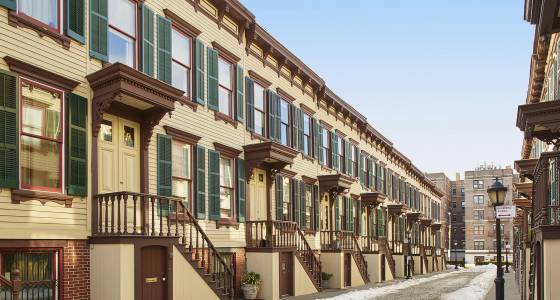In New York City, especially in 2017, it might seem impossible to live along a secluded, cobblestoned mews. Especially one lined with 20 handsome yellow-painted wooden rowhouses sporting green shutters.
It’s the kind of thing that only exists in the 19th century, Europe or the movies, right?
It’s not. In Washington Heights, Sylvan Terrace meets these exact characteristics. It’s one of the city’s “secret streets,” such as Pomander Walk, Sniffen Court and Love Lane Mews — tucked-away blocks home to exclusive real estate that doesn’t become available very often.
But a three-story rowhouse at 16 Sylvan Terrace is currently on the market — and at a discount, too, as first reported by Curbed.
Stribling & Associates
Stribling & Associates
Stribling & Associates
Stribling & Associates
View Slideshow
This two-bedroom pad originally asked $1.7 million last year before lowering its asking price to $1.65 million. But following a brokerage swap, the property has returned to market asking a reduced $1.62 million, StreetEasy shows.
The fully renovated 1,425-square-foot home blends old and new. Double-entry doors lead to a parlor with Brazilian cherry wood floors, crown molding and double-height windows. There are also gas fireplaces on each floor, radiant-heat flooring on the first level, central air and a new kitchen with stainless-steel appliances, soft-touch drawers and subway tiling. There’s an option to add a third bedroom that appears as an office in the listing photos and on the floor plan.
On the garden level, there’s an outdoor space that measures approximately 10 by 9 feet, the floor plan also shows.
Sylvan Terrace is a landmarked street that used to be the carriage drive to the 1765-built Morris-Jumel Mansion, which George Washington used as his temporary headquarters during the American Revolution.
Lori Huler Glick and Cortney Appelbaum of Stribling have this listing.
Our editors found this article on this site using Google and regenerated it for our readers.












